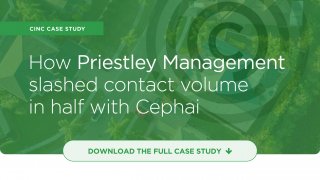- June 19, 2020
- CINC Systems

In order to thrive in an ever-changing tech-centric world, today’s businesses are compelled to conform and adapt. Demand for real-time data access and technology that allows customers to “do more with less” can make it difficult for companies to stay ahead of their competition while remaining profitable.
Upgrading and maintaining the latest business software has been historically expensive. For example, on-premises infrastructure is costly to install, requires an IT staff to maintain, and costs many thousands of dollars. Additionally, capacity constraints on single-tenant legacy software solutions make them inherently difficult to scale.
Move your association management business to a cloud-based multi-tenant SaaS (software as a service) solution and experience untethered scalability. With a cloud-based SaaS solution, your business can expand and add users without needing to upgrade hardware. Investing in a SaaS company may be the smartest company decision you can make.
What Is a SaaS-Based Management Solution?
It is important to understand the difference between true multi-tenant SaaS and other online accessible software.
Subscription-Based Model
Subscription-based SaaS inherently reduces the cost of owning your software infrastructure. Some SaaS companies charge an annual subscription fee, while others bill quarterly, monthly, or weekly; furthermore, SaaS fees can be calculated into your monthly budget. On-premises solutions and basic remote-access software require an investment for software licenses, in-house server hardware, and an IT support staff.
Multitenant Functionality
Multitenancy SaaS means that multiple customers are served by a singular instance of cloud-based software and its backing infrastructure. There is no software to install. Simply subscribe and log in via your normal internet browser.
Basic cloud-based remote access legacy solutions, such as single tenancy, require each customer to have his or her own software instance and an independent database. Furthermore, legacy users experience similar limitations to on-premises solutions:
- Hard to scale
- No database or software sharing
- Cumbersome software upgrades and updates
- Expensive to maintain
- Capacity constraints
Advantages of Association Management SaaS-Based Software
Whether you manage a large portfolio of homeowner associations (HOA) or a single condominium association (COA), switching to a SaaS-based program can help you provide next-level service to your clients. Here are several advantages to consider.
1. Instantaneous Updates
Legacy system software upgrades necessitate massive file downloads and lengthy installation time, leading many companies to delay this process. In other instances, software updates require companies to purchase a new version and install it from scratch, and it’s not uncommon for traditional software updates to warrant a newer computer system.
Companies leveraging SaaS-based programs enjoy constant updates and upgrades deployed automatically to all users at no additional cost, which means your software is always up-to-date with access to the latest features and functionality.
2. Cost-Effective Set-Up
The often steep up-front costs of a legacy software set-up, plus IT, software, and hardware overhead can make it far less cost-effective than the subscription-based model of a SaaS system.
Because SaaS is a subscription-based, pay-as-you-go model, the start-up fee is essentially zero. You are not buying and owning the software, so you pay only for what you use to operate your business, turning capital expenditure into operational expenditure.
Additionally, a SaaS rollout is nearly instantaneous. Large, growth-oriented property management companies can launch a cloud-based system nationally or globally and sidestep the cost associated with those deployments. There is no need to hire on-site IT experts to install software or trouble-shoot upgrade glitches and since no supplemental hardware is required, you can avoid the time and cost it would require installing and procure a virtual private network (VPN) and an IT infrastructure across numerous sites.
3. Worry-Free Data Protection
SaaS providers encrypt their cloud-based data. This means sensitive data is encoded once it is uploaded and can only be decoded by someone using the proper SaaS program and password. Thus, in the event of a data breach, encryption ensures that your clients’ data remains protected.
By outsourcing to a SaaS provider, your company’s sensitive information is further guarded by a team of data security specialists. Client platforms, applications, servers, and data are proactively managed. Your association management software is fortified with intrusion prevention systems, access controls, antivirus software, and firewalls rendering threats like denial-of-service, brute-force, and malware attacks a thing of the past.
SaaS security also means peace of mind in case disaster strikes. Organizations that fully or partially utilize legacy systems are vulnerable to internal and external threats that could seriously interfere with business continuity. Even if data is backed up and stored on-site, or across town, it may not be safeguarded from a catastrophe like a fire, flood, or hurricane.
SaaS uses cloud resources to protect and back up databases, files, software, and applications from the disruption caused by calamity or theft. A SaaS solution enables continual operations during and after disaster recovery execution.
4. Lag-Free Performance
The speed and performance of a single-tenant legacy system are only as reliable as its in-house servers. Your burgeoning business would quickly exceed a legacy server’s capacity, forcing your company to buy and install additional hardware and potentially increasing your IT department.
Because SaaS solutions are built to accommodate its potential universe of users, capacity is never an issue. Multiple users can be logged into the software at once, running multiple reports, with no impact from a speed or usability standpoint.
5. Amplified ROI
Return on investment (ROI) is one of the most widely used metrics of a company’s success and it is one of the main reasons to consider SaaS.
Software ownership, conventional licensing, limited user numbers, and maintenance costs lead to capacity-utilization gaps similar to on-premises hardware systems. The on-demand, usage-based pricing of a SaaS system closes these gaps and leads to improved ROI. Here are a few other ways SaaS can enhance your ROI:
- High capacity utilization — A multitenant SaaS provider like CINC can attain higher capacity utilization which translates to lower costs for its customers.
- Economy of scale — SaaS systems spread out IT costs over a large user base. An issue encountered by a single user may, once solved, be proactively fixed for all SaaS users.
- Cost reduction — With a SaaS-based solution, boosted management efficiency, increased productivity, and diminished overhead leads to higher cost reduction and improved ROI.
Try CINC Systems for SaaS-Based Association Management Solutions
Cloud-based SaaS models like CINC deliver affordable and accessible business solutions to association management companies of any size.
CINC’s all-in-one platform provides banking, accounting, financial reporting, property management, board management, and homeowner communication solutions and uses centralization, automation, and integration to improve the efficiency and profitability of your association management business.
If you’re not already using SaaS-based technology for your business, try CINC Systems today. To request a free software demo, click here.
Related Reads

Blog
How Priestley Management slashed contact volume in half with Cephai
- July 22, 2024

Blog
Get Ready: Homeowner Associations Must File Under the Corporate Transparency Act
- July 8, 2024

Blog
Generative AI just got a lot more mainstream. Is your community association ready?
- July 1, 2024

Blog
Celebrating Pride Month: CINC Systems Employees Share Inclusivity Wisdom and Advice
- June 28, 2024

Blog
Mid-Year Update: Using the 2024 State of the Industry Report to Drive Business Growth
- June 10, 2024

Blog
4 Ways Cephai Makes Pool Season a Breeze for Community Managers
- May 27, 2024
